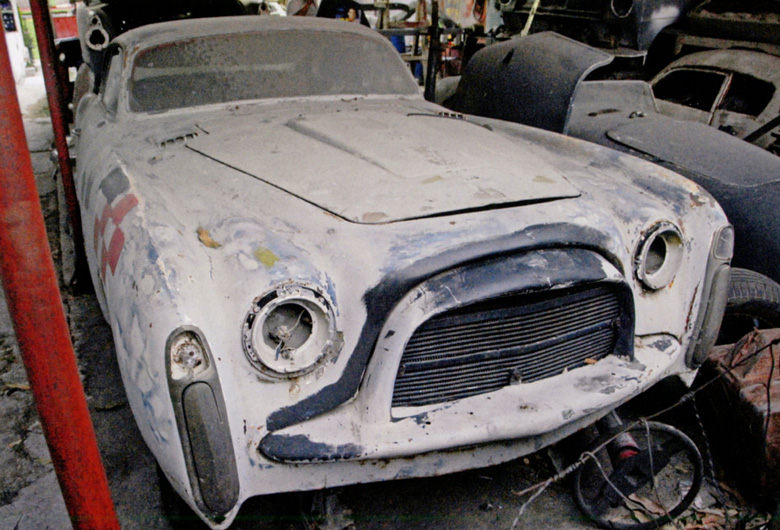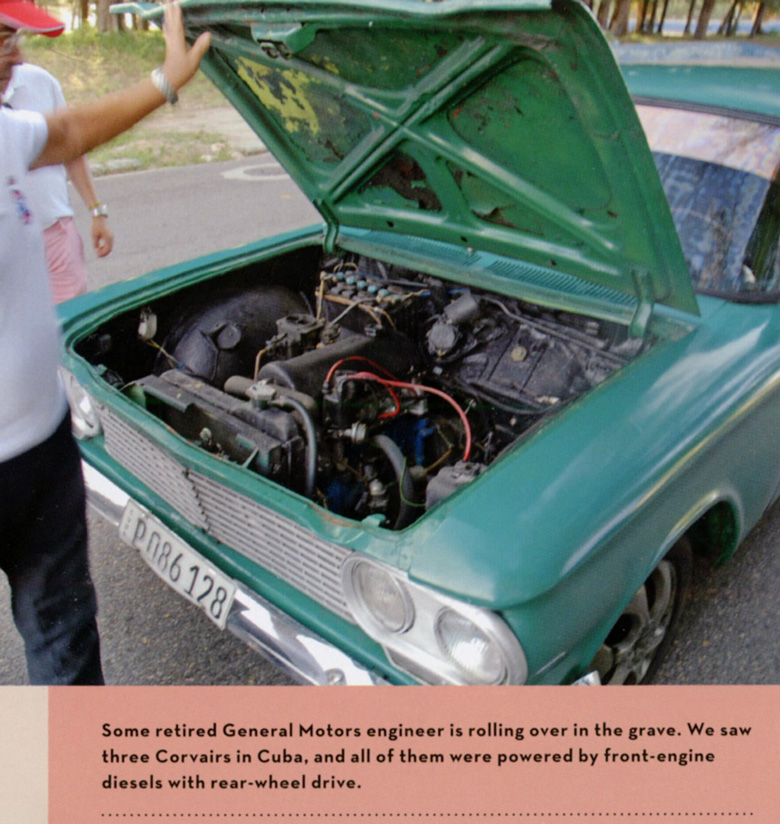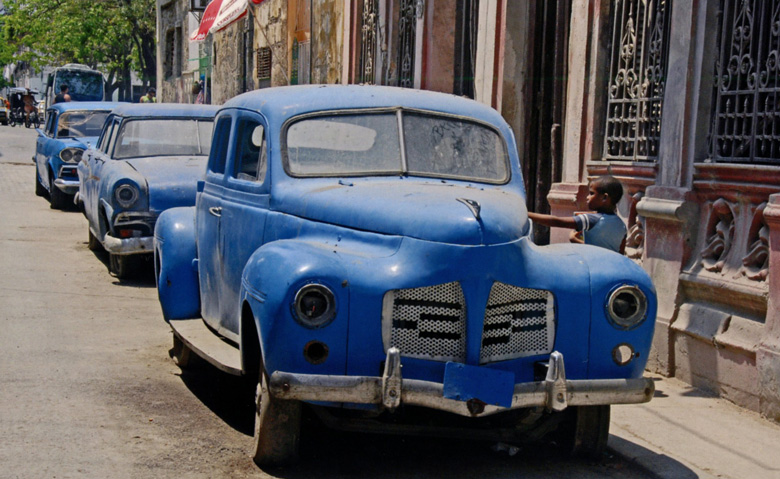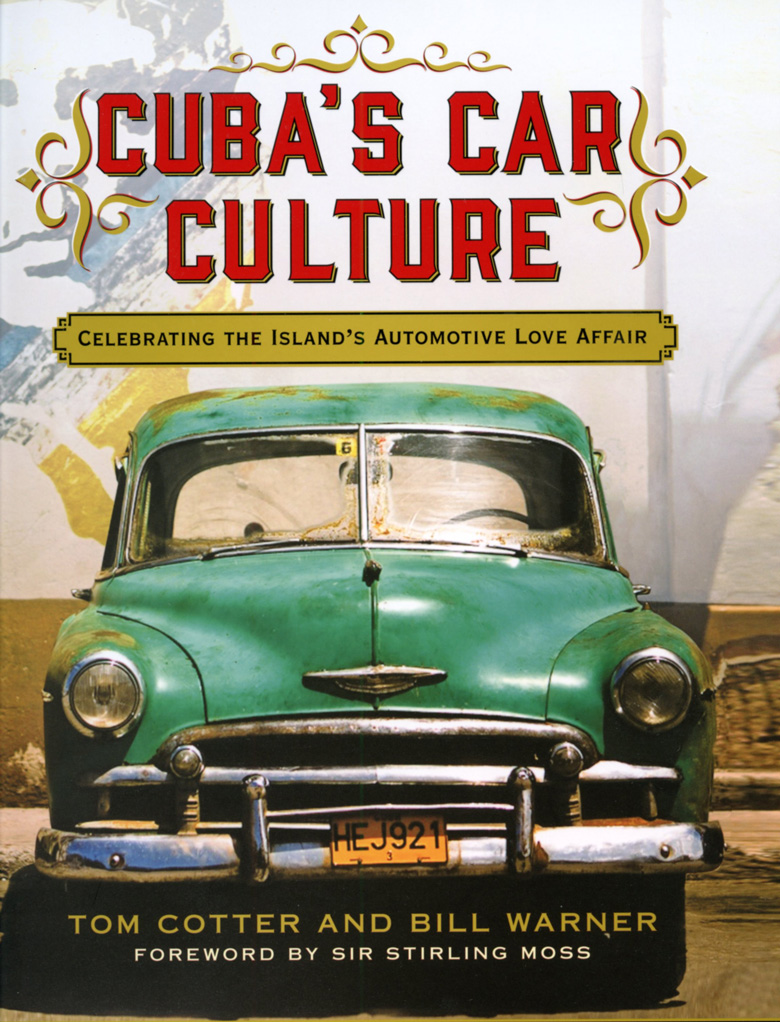Ready to book a flight to Cuba in search of classic cars? Read this first…
Hardcover, 192 Pages
ISBN 9780760350263
160 color illustrations
9.25 inches by 10.875
October, 2016
$35 USD
Motorbooks Interenational
Order from www.QuartoKnows.com
Review by Pete Vack
Photos from the book by Bill Warner
Amelia Island’s Bill Warner and Cobra in the Barn author Tom Cotter have teamed up to create a new book that describes the cars and the culture of Cuba as it exists today. But as the book was written just as diplomatic relations between Cuban and the U.S. were being restored, the face of Cuba and its car culture will most certainly change radically in the years to come. If you want to see Cuba as depicted by the authors, don’t wait too long to visit. But don’t plan to take back a classic Ferrari, hidden in the Cuban undergrowth for sixty years. Odds of that happening are slim, as the authors explain.
This book is one of the few books I’ve suggested be read from back to front. As one thumbs front to back through the beautifully illustrated book, for most enthusiasts, the first impulse is to hop on a plane and go find that Porsche Carrera, BMW 507, or Cisitalia that are just waiting to bought at bargain prices and shipped back to the U.S. After all, just last week we reported on how Colin Crabbe (The Thrill of the Chase) went to Cuba and shipped out an XKSS Jag and Ferrari TRC. Before your fantasies have a chance to take root, go to Chapter 12, “You Can’t Bring Them Home”. With that dose of reality, enjoy the rest of the book.
An informative book about the myth and the reality of the Cuban car culture.
Instead of just presenting artful photos of old Chevys and Fords lounging about in the streets of Havana as if it were a sunny day in 1959, Cotter and Warner actually tell us about them and investigate everything from parts-starved auto parts stores to car rallies and (outdoor!) car museums, to the condition of the roads and highways to Cuban restoration shops. They tell us how to fly there, the money exchange, how to buy a cellphone (yours won’t work in Cuba).

Ernest Hemingway bought a home in Cuba in 1940. In 1955 he bought this then red Chrysler Hemi convertible to drive to Havana. It is now undergoing a major restoration.
There are chapters on the history of motoring in Cuba, Cuban car dealerships and the few races that have been held in Havana before Castro came to power. The authors visited Hemingway’s old home and found one of his cars, then awaiting restoration and discovered that the man who is having this Hemingway Chrysler restored is David Soul, the actor who played Hutch in the series Starsky and Hutch. The authors rented a Chinese car called the Geely Emgrand (similar to a Toyota Corolla) for about $120 per day and described driving around the island, breaking in the Geely by accidentally nailing a dozen major potholes…a major road hazard in Cuba.

Close but no cigar…If that Corvette front fender line doesn’t seem quite right, it is because the entire front end is fabricated in steel. Sculptor and car nut Esterio Segura poses by his car.
In many ways the book serves as a down-to-earth bible for the car nut in Cuba. Their guide is a Cuban car enthusiast who knows the nooks and crannies and even more important, introduces them to several Cubans who are typical of the Cuban car enthusiast, and who face unusual problems. After an accident, sculpture Esterio Segura replaced the front of his 1954 Chevy Corvette with steel instead of fiberglass – steel being more plentiful in Cuba than fiberglass.
One of their contacts had a Mercedes 300SL and one of the twelve Chrysler Ghias, but restoration efforts are hampered by lack of parts. One way to restore in Cuba is to use the existing, original parts and material. Dr. Armando S. Miari de Casas restored his Austin Healey using all original parts. “In Cuba,” he said, “you must work with every original nut, bolt and part, because there are no replacements.”

And there it sits, one of the twelve or so Chrysler Ghias made in the mid-fifties. Cotter points out that yes, the Cubans do have Internet access and are very aware of the value of their cars.
Cotter figures that the Cuban mechanics must be among the best improvisers in the world. They have kept the same cars running for over sixty years with no factory spare parts. But one of the secrets is that many of the old American cars have been modified to accept Russian diesel engines and drivetrains from Russian tractors – even Corvairs have been modified to be front engined, diesel powered. Another secret is the pollution that has resulted from the lack of anti pollution laws…something not apparent in the many artistic images of the cars of Havana.

We just had to include this photo and the caption; the epitome of the Cuban ability to make anything driveable.
The images that others have conjured up of Havana often portray beautifully kept American cars from the 1950s against a backdrop of slightly decayed pasteled buildings. (Many such photos, from Getty Images and the camera of ex-Road & Track photographer Bill Warner, grace the pages of this book as well.) These iconic images have helped to create a Cuban “brand”, such as French baguettes or the Argentine tango. But Cotter tells us that “The colorful Cuban cars you see on the Discovery Channel, or in Traveler magazine, don’t tell the full story. When you read about the impeccably restored classic American cars, don’t believe a word of it.”

Thousands of old American cars can be found on the streets of Cuba, but they are rarely in great shape. The Plymouth, Ford and Rambler in this photo are pretty rough all appear to have been treated to the same paint shop.
Cotter goes on to destroy the romantic myth. “The Cuban people are so tired of these old pieces of shit cars,” his translator told him. And if you are thinking that you’ll get a deal on an old Caddy, remember that many of these cars have Russian diesels or are great too look at – from 100 yards. Cotter advises that if you are in the market for an old American car, shop Stateside.

Cotter and Warner spotted this immaculate 1959 Buick convertible being used as a taxi in the historic district of Havana. It was a nice as any seen in the U.S., proving that not all Cuban classics are 100 yard wonders.
But. The free marketplace is a strange and wonderful thing. It is entirely possible that in ten to twenty years, when these self-same POS have disappeared from the streets of Cuban cities, they will be eagerly sought after, recreated, driven in rallies and hailed as objects of art from the good old days. And of course worth a small fortune. So perhaps, let the seller, not the buyer, beware.
Part travelogue, part history, part excellent journalism, Cuba’s Car Culture should be read by any car enthusiast contemplating a trip to Cuba.

Based on two trips to Cuba (and not to any of the resorts) I would say that this review jibes with my impressions of the old car situation in Cuba.
You have to remember that these are “million-mile” cars that have been kept on the road by improvising repairs using any parts at hand. The car with a tractor or irrigation pump diesel engine is commonplace — indeed many cars that seem to be classic ’50s car are merely the shell draped over the chassis of a Russian jeep or truck.
In my tourist travels I never saw a ’50s car worth anything –even for scrap — in an open market.
My thought is that the best thing to do with these cars is to assemble a museum in Havana (and one in Santiago de Cuba) of these cars “as is” to serve as relics of a time which may rapidly disappear.
If the Cubans can ever afford to buy replacement cars, these relics will soon disappear from daily use — except as tourist attractions.
I can confirm that the Hemingway New Yorker is the car owned by the author. I met the then owner at the Muséo Hemingway in ’92 and published a detailed account in the Miami Herald’s Tropic (Sunday) magazine Dec 12, ’93. I’ve heard from others that this does not come up on searches but is available from the Herald’s archives.
The Cuban owner traced the last registration to Hemingway’s doctor, in keeping with Hemingway’s practice of never trading in his cars.
The Chrysler’s “provenance” can be described only in the fantastical realm of confusion, contradictions, and surprises typical of every adventure in Cuba. Bottom line: the authorities in Havana are remarkably candid and reliable; the confusion comes from outside sources.
During the transfer of title to the musem, which took about 18 years with help from the City Historian’s office, I carried a new set of dual points to the museum and sent factory color codes and ID badge locations to the museum.
The fictional car was written into a book by Florida author Randy White, then in Havana Bay by MC Smith.
The museum concluded the transfer in late 2010, and I’ve been contacted by a journalist working with David Soul about the restortion status and a documentary video described on Soul’s web site. That the work has gone of for four years already is not surprising. The museum director’s account of the months involving their Customs and the US’s OFAC regulations could fill a long article about shipping one leaf spring to them.
Poor David Soul, a Canadian citizen with plenty of good will and on the hook for a reported $100k for the restoration, has been put through the wringer by US officials for his efforts.
The car’s completion date is open, but the Chrysler, rising like Phoenix from the burned out hulk I saw in ’92, with the original Hemi thundering through no mufflers, has become a significant artifact of Cuba’s rich culture, solid proof of the fact that Cuba’s people, specifically the museum officials and govt officials up to and including Fidel, maintain a deep reverence for Hemingway and his estate.
I’ve been told that the body work is complete and have made an informal request to be there the day the car returns home like new, whenever that may happen.
This story really does have legs. My last contact with the Cuban owner was in person in ’97. He had survived his raft escape in ’93. The car was hidden in a secret location, negotiations were underway to donate the car to the musem, with conditions. After 19 years of wondering where he is, and hearing from many journalists about him and the car, I got an e-mail this week from him. He had been looking for me for years, and is planning to call today. Your timing is perfect, and I’m looking forward to his account of how His Chrysler was donated and the terms.
It seems like Bill Warner and his co-author got their facts right by approaching the Cuban authorities with respect. It is, no question, the car owned by Hemingway. The car’s secret location is no secret, but the museum director has kept her end of her exclusive deal with David Soul that no photos are allowed.
A most amusing tale about the car was published in the WSJ about 4 years ago by a first time visitor who assumed the Chrysler was raoming Havana’s streets and he planned to find it.
Kudos to these two authors for their sincere approach and getting the story right.
Hopefully, the Chrysler’s arrival at the Finca next year (?) will complete a trifecta they have been working on for over 25 years: the house and boat restoration were completed several years ago, the Chrysler is the final jewel. When that happens, gearheads worldwide will have another reason to visit the museum.
Keep in mind that the car, boat, and house with Hemingway’s 8,000 volume library would have been lost to decay, neglect, and looters as happened to the fabled Steinhart house a short walk through the woods from the Finca.
While it is true that mansions of those who left Cuba were nationalized by the new government, the Finca is the only exception of which I’m aware. That Fidel carried a copy of For Whom The Bell Tolls with him during the Revolution is well documented, as is his respect and admiration for Hemingway, even though they met only once. On direct order from Fidel, the mandate was given that the Hemingway estate and its contents must be preserved and protected. Since then, 55 years, the Finca’s security has been maintained, with armed guards, 24/7, as the massive restorations continued. When the New Yorker arrives home, credit belongs to the one man who probably does not want it, the leader who simply did the right thing.
I believe David Soul, who was born in Chicago, Ill. has dual US and UK citizenship, not Canadian.
gee isn’t it just swell to present a small good thing about the poor cuban people while overlooking the …there aren’t words bad enuf…cuban government, which i like to think is on its way to hell and can’t get there fast enough for any decent person. contemptible situation, but i guess a book is a book
David Meisner – Thanks for the cirrection. I had to ask his writer if he was Starsky or Hutch.
Toly Arutunof – This is a car thread in which I mentioned Fidel’s role as part of the car’s background history.
The “government” isn’t going to hell as you like to think. And not fast enough for any decent person? Millions of decent people recognize the government’s advances, from Pope Francis to the Secty General of the UN to Predident Obama.
It’s a car story. Like them or not, Fidel and the City Historian are part of it. If you imagine Cuba is going to hell, I’d guess you haven’t been there lately? Nor to Honduras, Hell itself, or Salvador, or Guatemala. Those are true hells created by US policy that Fidel blocked in 1960.
Try to move on from demonizing Fidel by seeing Cuba today. Read the UN’s 2015 DNI – Developing Nations Index – their survey of standard of living and access to services. Cuba ranks 47th worldwide, 4th in this hemisphere after the US, Canada, and Chile. Blame Castro for that, for Cuba placing ahead of every other Latin American country; Brazil, Mexico, Argentina, and Costa Rica included. Gun culture, police executions, mass graves, and armed gangs found in Central America do not exist in Cuba.
Hemingway was a car guy, so are Fidel and Pope Francis. Enjoy the ride.
Mark:
Fortunately I am old enough to have lived in Cuba during the late 40s and 50s and the first few years of the so-called revolution. Just for your information, and I don’t want to develop this thought into a political thread, but since you made a defensive comment to a remark by another reader, the UN generates its standard of living and services reports on what it is fed by the participating countries. When you visit Havana next time just go to a Catholic church on any given Sunday to witness the beatings of the Ladies in White as they attempt their weekly assistance to Mass. Please visit a city hospital (not one for foreigners with dollars and Party elite) and see what it is like not to be able to flush a toilet for lack of water, kill the roaming rats and have to bring your own bedding and anesthesia. Then try to make a living on the equivalent of US$22 per month while the government charges the foreign company employing you US$1,600 per month. FYI, I understand that the last remaining Testa Rosa, of the 3 in the island before the revolution, is in the collection of Raul Castro. The one belonging to Architect Albarran was sold to Luigi Chinetti of NART after the Nassau Trophy Races of I believe 1960. The other one was destroyed in a crash at one of the last Cuban Grand Prix. Yes, we had plenty of Alfas, MGs, Austin Healys, Jags, Porsches, Mercedes Gull Wings, Ferraris and of course, American Muscle. We have plenty of old Cuban race car drivers that have a treasure trove of information regarding the history of the sport and the Cuban teams that raced at Sebring, Nassau, LeMans, etc. We even started racing clubs in South Florida and were directly responsible for the Miami Grand Prix and getting the Homestead Speedway built.
Thanks to your car guy, Fidel, Cubans can no longer enjoy what once was akin to a national sport. His family owns plenty of Hummers and other exoticsm, though. And please, no “blame the Americans b.s.; we know much better than that.
And any book regarding Cuban automotive history is welcomed.
And any comment putting Fidel Castro’s name (a mass murderer) with Pope Francis is either blatant blasphemy or complete ignorance.